实例介绍
【实例截图】
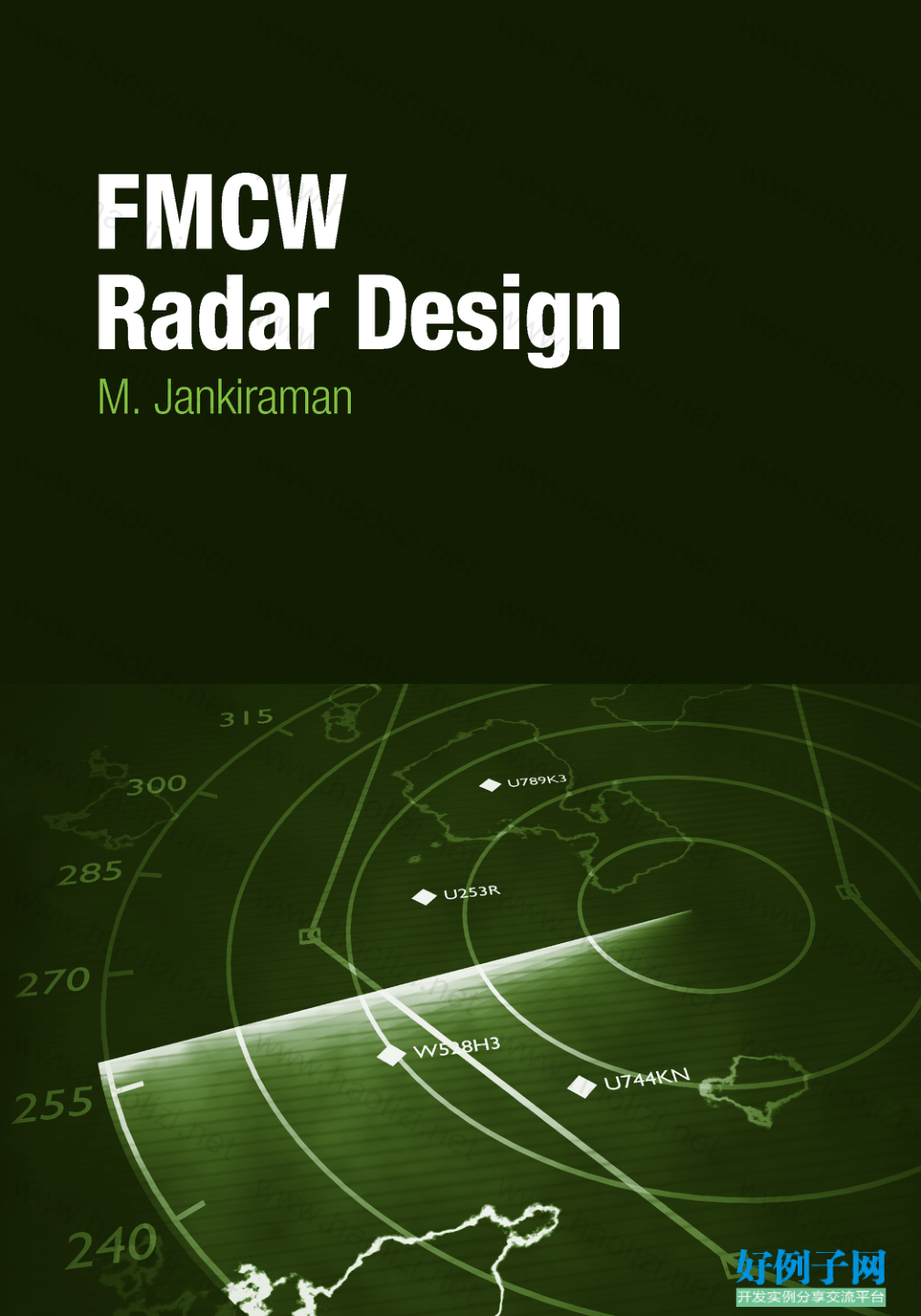
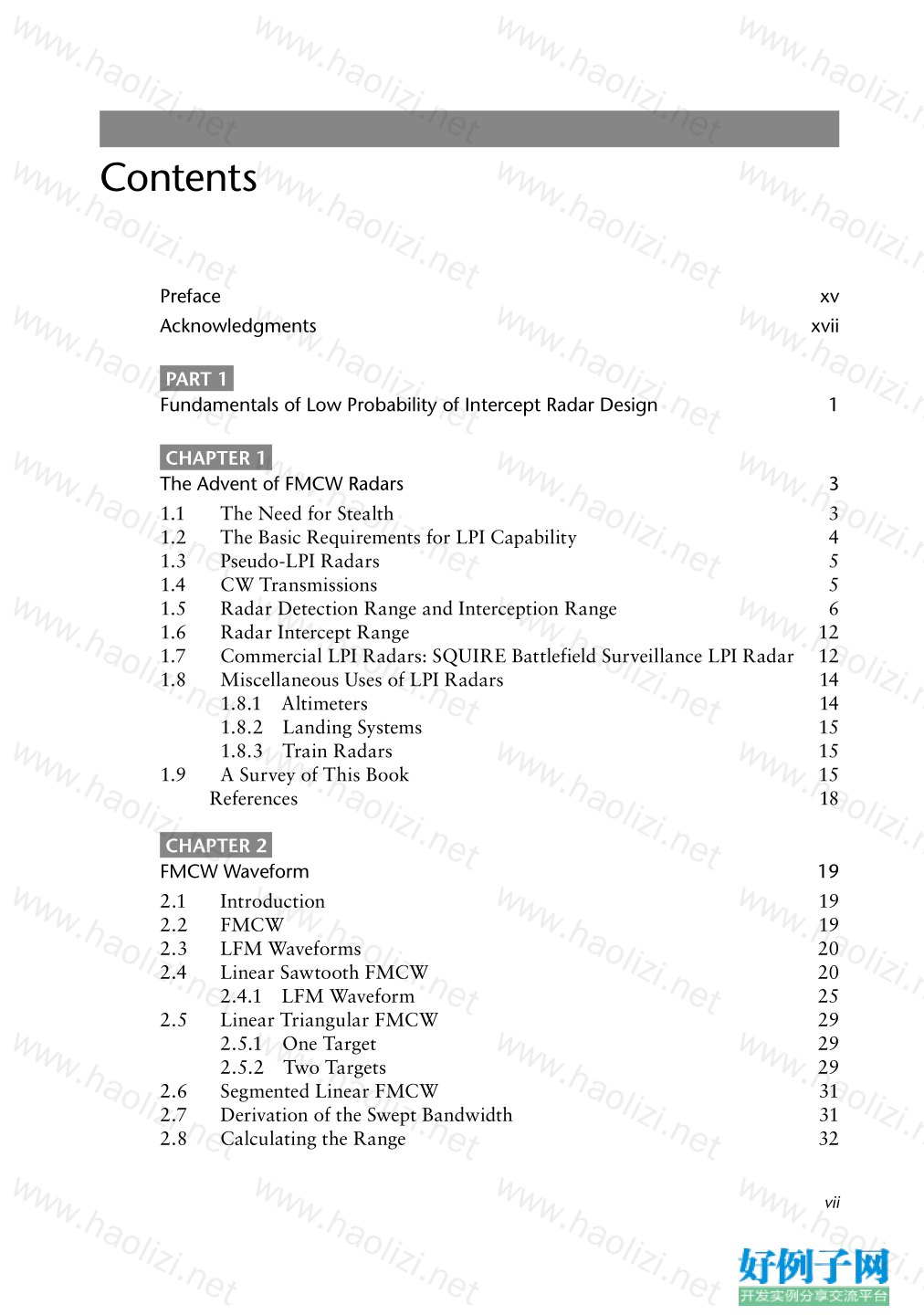
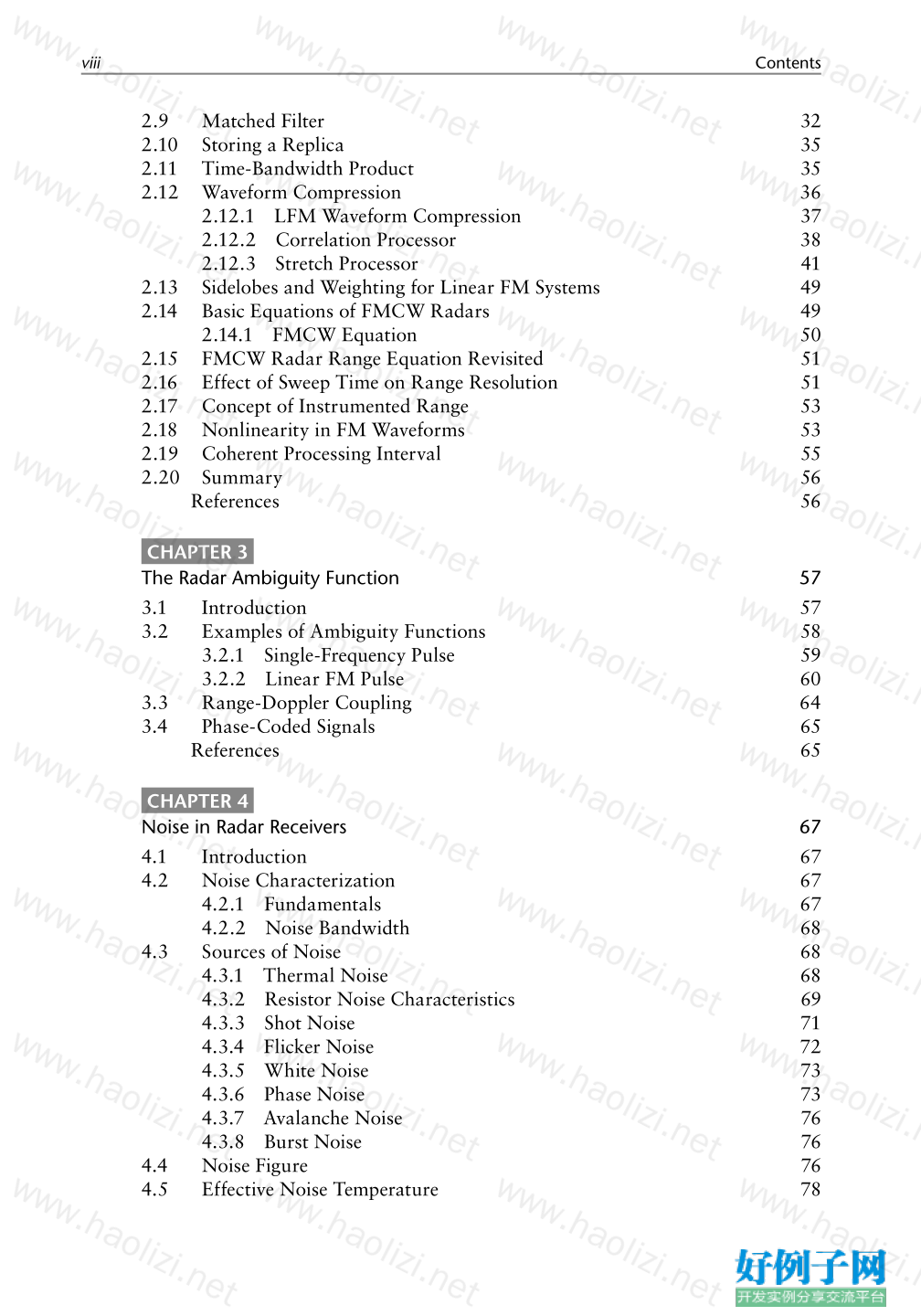
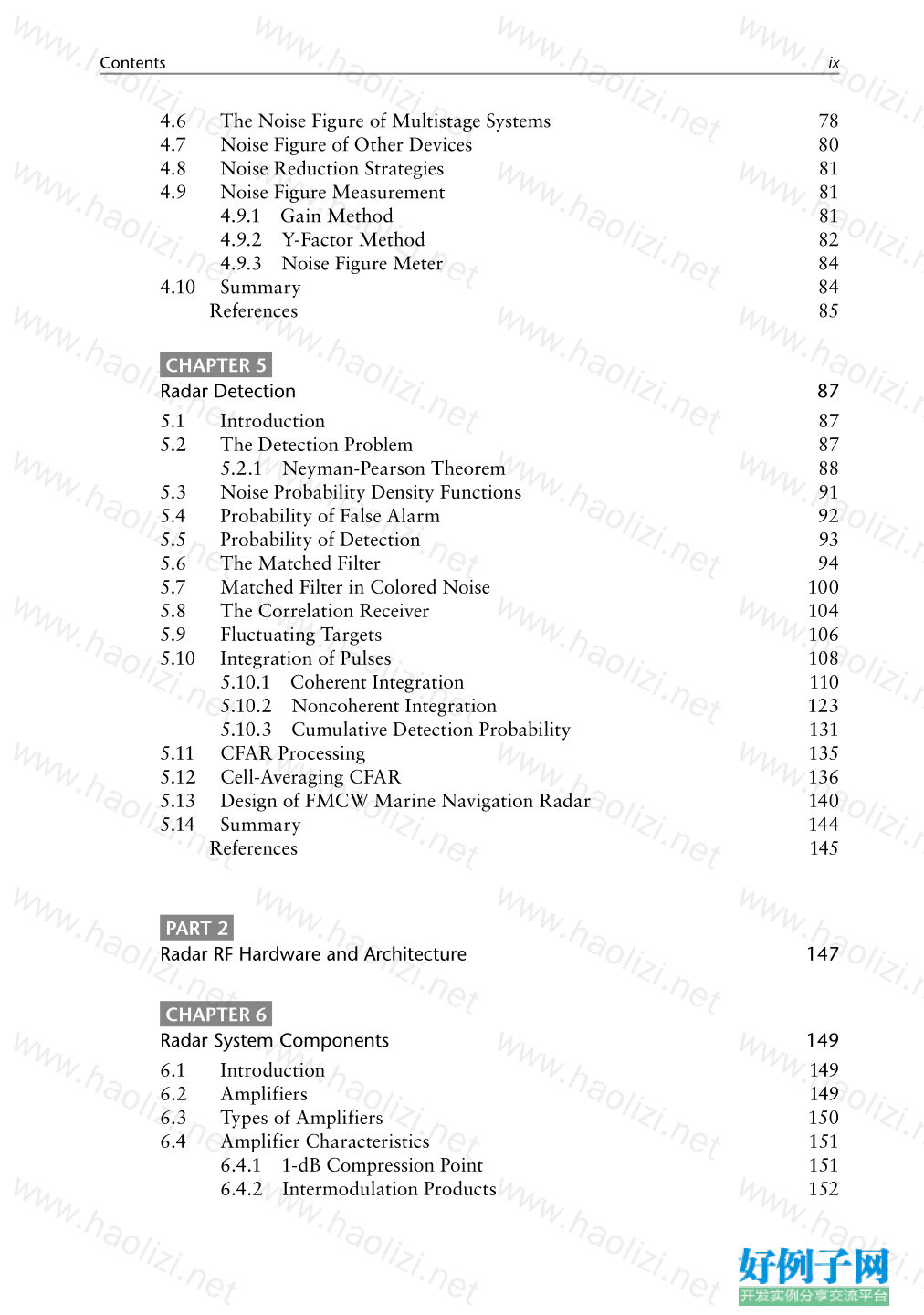
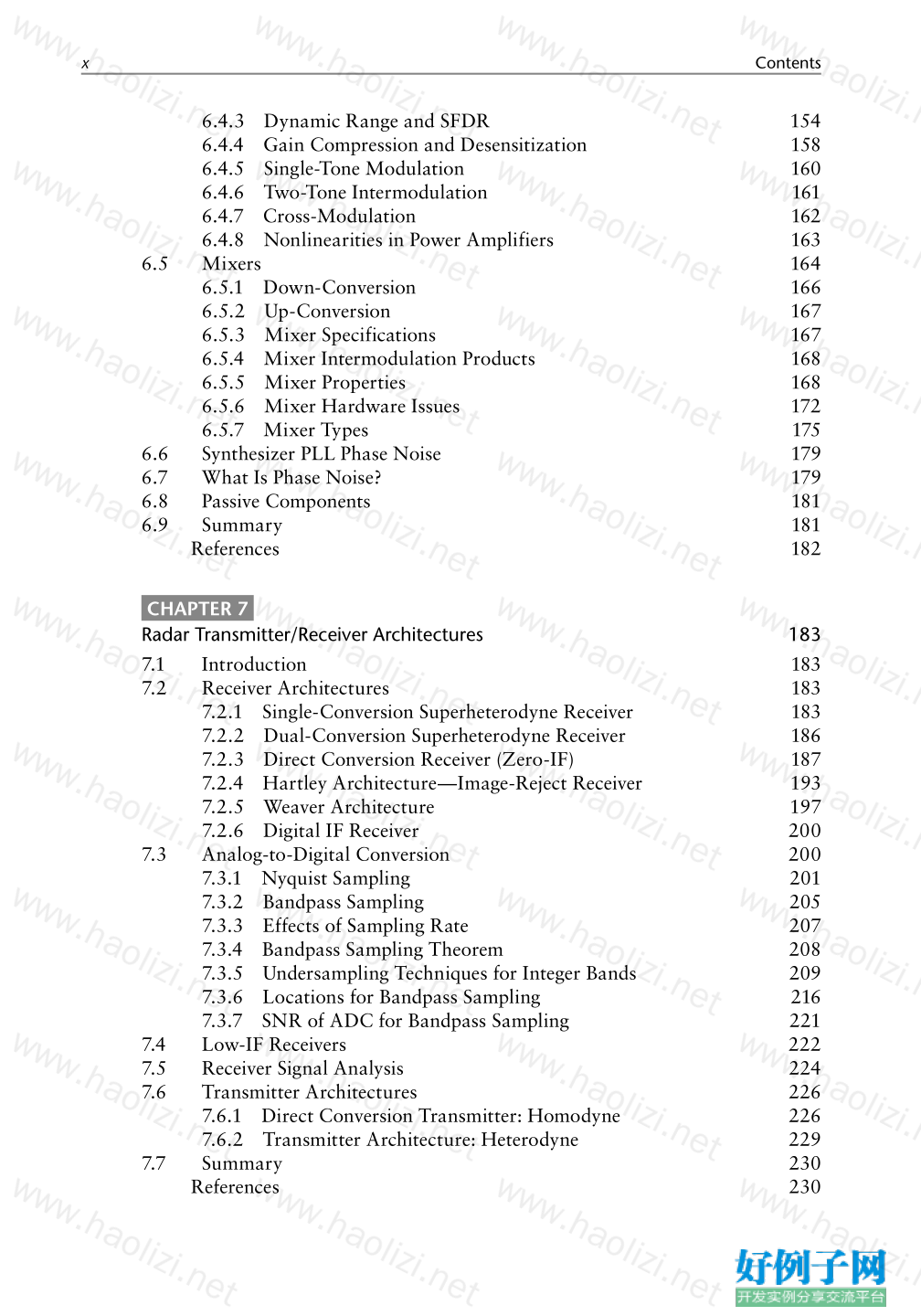
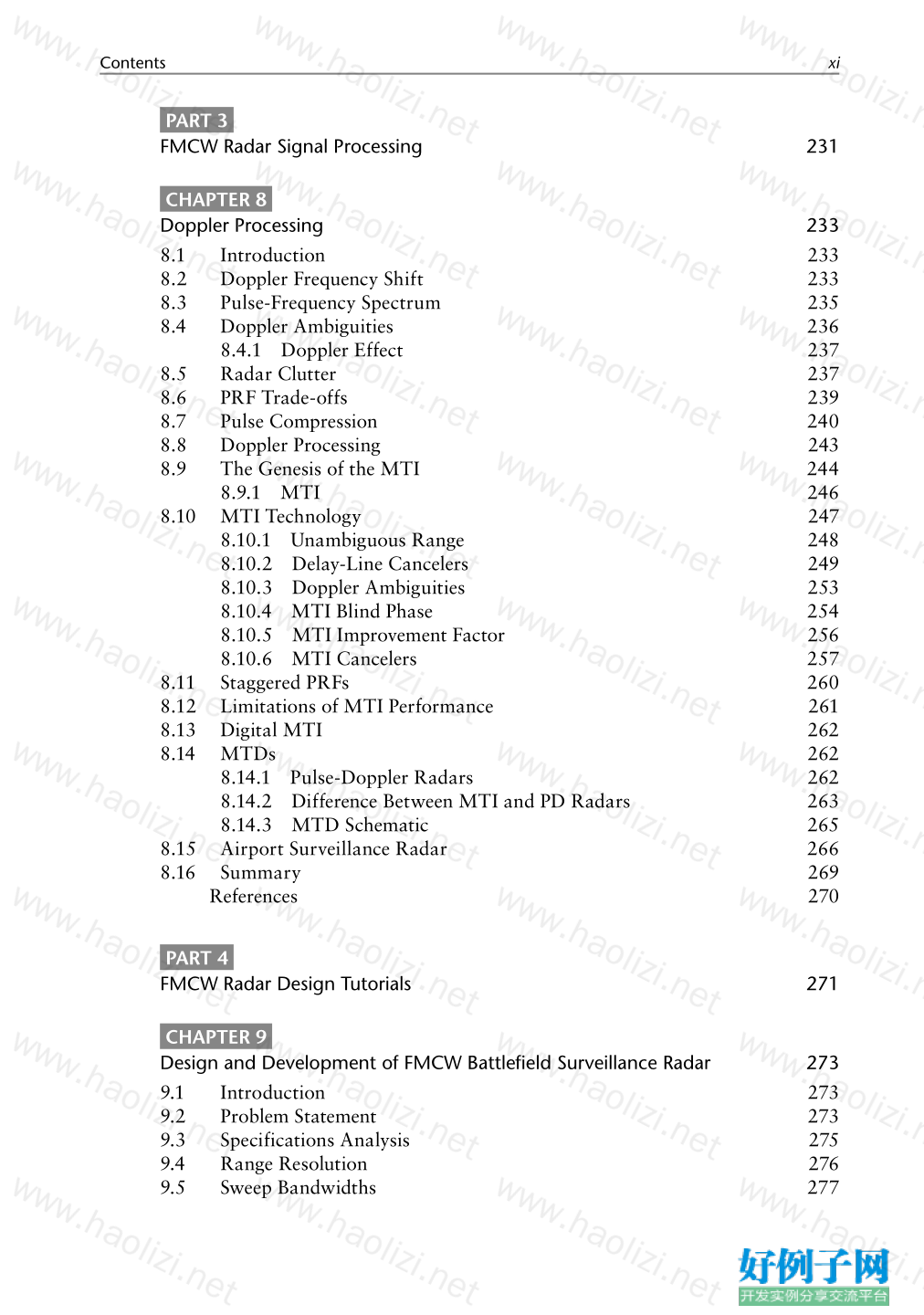

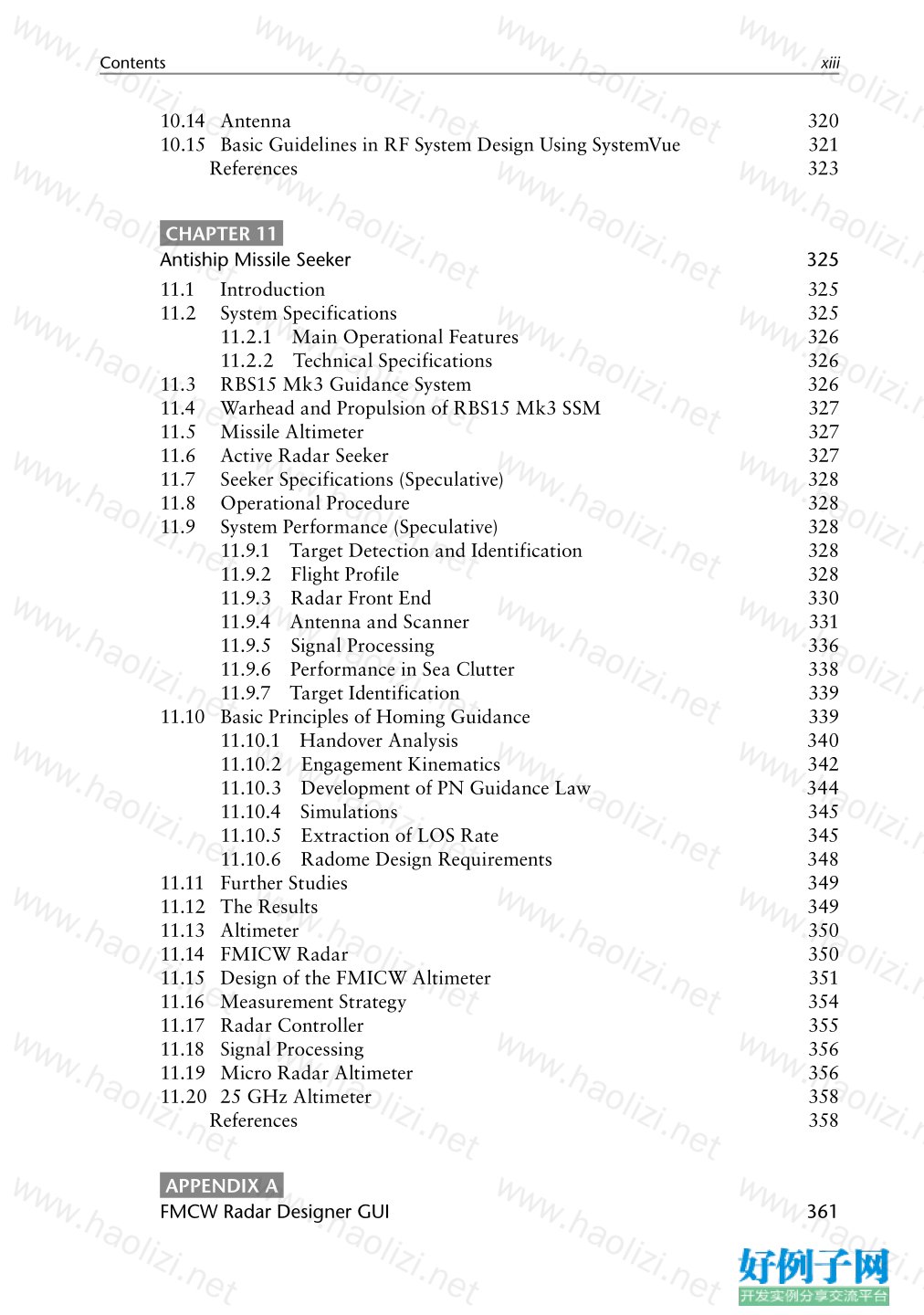

【核心代码】
Contents
Preface xv
Acknowledgments xvii
PART 1
Fundamentals of Low Probability of Intercept Radar Design 1
CHAPTER 1
The Advent of FMCW Radars 3
1.1 The Need for Stealth 3
1.2 The Basic Requirements for LPI Capability 4
1.3 Pseudo-LPI Radars 5
1.4 CW Transmissions 5
1.5 Radar Detection Range and Interception Range 6
1.6 Radar Intercept Range 12
1.7 Commercial LPI Radars: SQUIRE Battlefield Surveillance LPI Radar 12
1.8 Miscellaneous Uses of LPI Radars 14
1.8.1 Altimeters 14
1.8.2 Landing Systems 15
1.8.3 Train Radars 15
1.9 A Survey of This Book 15
References 18
CHAPTER 2
FMCW Waveform 19
2.1 Introduction 19
2.2 FMCW 19
2.3 LFM Waveforms 20
2.4 Linear Sawtooth FMCW 20
2.4.1 LFM Waveform 25
2.5 Linear Triangular FMCW 29
2.5.1 One Target 29
2.5.2 Two Targets 29
2.6 Segmented Linear FMCW 31
2.7 Derivation of the Swept Bandwidth 31
2.8 Calculating the Range 32
viii Contents
2.9 Matched Filter 32
2.10 Storing a Replica 35
2.11 Time-Bandwidth Product 35
2.12 Waveform Compression 36
2.12.1 LFM Waveform Compression 37
2.12.2 Correlation Processor 38
2.12.3 Stretch Processor 41
2.13 Sidelobes and Weighting for Linear FM Systems 49
2.14 Basic Equations of FMCW Radars 49
2.14.1 FMCW Equation 50
2.15 FMCW Radar Range Equation Revisited 51
2.16 Effect of Sweep Time on Range Resolution 51
2.17 Concept of Instrumented Range 53
2.18 Nonlinearity in FM Waveforms 53
2.19 Coherent Processing Interval 55
2.20 Summary 56
References 56
CHAPTER 3
The Radar Ambiguity Function 57
3.1 Introduction 57
3.2 Examples of Ambiguity Functions 58
3.2.1 Single-Frequency Pulse 59
3.2.2 Linear FM Pulse 60
3.3 Range-Doppler Coupling 64
3.4 Phase-Coded Signals 65
References 65
CHAPTER 4
Noise in Radar Receivers 67
4.1 Introduction 67
4.2 Noise Characterization 67
4.2.1 Fundamentals 67
4.2.2 Noise Bandwidth 68
4.3 Sources of Noise 68
4.3.1 Thermal Noise 68
4.3.2 Resistor Noise Characteristics 69
4.3.3 Shot Noise 71
4.3.4 Flicker Noise 72
4.3.5 White Noise 73
4.3.6 Phase Noise 73
4.3.7 Avalanche Noise 76
4.3.8 Burst Noise 76
4.4 Noise Figure 76
4.5 Effective Noise Temperature 78
Contents ix
4.6 The Noise Figure of Multistage Systems 78
4.7 Noise Figure of Other Devices 80
4.8 Noise Reduction Strategies 81
4.9 Noise Figure Measurement 81
4.9.1 Gain Method 81
4.9.2 Y-Factor Method 82
4.9.3 Noise Figure Meter 84
4.10 Summary 84
References 85
CHAPTER 5
Radar Detection 87
5.1 Introduction 87
5.2 The Detection Problem 87
5.2.1 Neyman-Pearson Theorem 88
5.3 Noise Probability Density Functions 91
5.4 Probability of False Alarm 92
5.5 Probability of Detection 93
5.6 The Matched Filter 94
5.7 Matched Filter in Colored Noise 100
5.8 The Correlation Receiver 104
5.9 Fluctuating Targets 106
5.10 Integration of Pulses 108
5.10.1 Coherent Integration 110
5.10.2 Noncoherent Integration 123
5.10.3 Cumulative Detection Probability 131
5.11 CFAR Processing 135
5.12 Cell-Averaging CFAR 136
5.13 Design of FMCW Marine Navigation Radar 140
5.14 Summary 144
References 145
PART 2
Radar RF Hardware and Architecture 147
CHAPTER 6
Radar System Components 149
6.1 Introduction 149
6.2 Amplifiers 149
6.3 Types of Amplifiers 150
6.4 Amplifier Characteristics 151
6.4.1 1-dB Compression Point 151
6.4.2 Intermodulation Products 152
x Contents
6.4.3 Dynamic Range and SFDR 154
6.4.4 Gain Compression and Desensitization 158
6.4.5 Single-Tone Modulation 160
6.4.6 Two-Tone Intermodulation 161
6.4.7 Cross-Modulation 162
6.4.8 Nonlinearities in Power Amplifiers 163
6.5 Mixers 164
6.5.1 Down-Conversion 166
6.5.2 Up-Conversion 167
6.5.3 Mixer Specifications 167
6.5.4 Mixer Intermodulation Products 168
6.5.5 Mixer Properties 168
6.5.6 Mixer Hardware Issues 172
6.5.7 Mixer Types 175
6.6 Synthesizer PLL Phase Noise 179
6.7 What Is Phase Noise? 179
6.8 Passive Components 181
6.9 Summary 181
References 182
CHAPTER 7
Radar Transmitter/Receiver Architectures 183
7.1 Introduction 183
7.2 Receiver Architectures 183
7.2.1 Single-Conversion Superheterodyne Receiver 183
7.2.2 Dual-Conversion Superheterodyne Receiver 186
7.2.3 Direct Conversion Receiver (Zero-IF) 187
7.2.4 Hartley Architecture—Image-Reject Receiver 193
7.2.5 Weaver Architecture 197
7.2.6 Digital IF Receiver 200
7.3 Analog-to-Digital Conversion 200
7.3.1 Nyquist Sampling 201
7.3.2 Bandpass Sampling 205
7.3.3 Effects of Sampling Rate 207
7.3.4 Bandpass Sampling Theorem 208
7.3.5 Undersampling Techniques for Integer Bands 209
7.3.6 Locations for Bandpass Sampling 216
7.3.7 SNR of ADC for Bandpass Sampling 221
7.4 Low-IF Receivers 222
7.5 Receiver Signal Analysis 224
7.6 Transmitter Architectures 226
7.6.1 Direct Conversion Transmitter: Homodyne 226
7.6.2 Transmitter Architecture: Heterodyne 229
7.7 Summary 230
References 230
Contents xi
PART 3
FMCW Radar Signal Processing 231
CHAPTER 8
Doppler Processing 233
8.1 Introduction 233
8.2 Doppler Frequency Shift 233
8.3 Pulse-Frequency Spectrum 235
8.4 Doppler Ambiguities 236
8.4.1 Doppler Effect 237
8.5 Radar Clutter 237
8.6 PRF Trade-offs 239
8.7 Pulse Compression 240
8.8 Doppler Processing 243
8.9 The Genesis of the MTI 244
8.9.1 MTI 246
8.10 MTI Technology 247
8.10.1 Unambiguous Range 248
8.10.2 Delay-Line Cancelers 249
8.10.3 Doppler Ambiguities 253
8.10.4 MTI Blind Phase 254
8.10.5 MTI Improvement Factor 256
8.10.6 MTI Cancelers 257
8.11 Staggered PRFs 260
8.12 Limitations of MTI Performance 261
8.13 Digital MTI 262
8.14 MTDs 262
8.14.1 Pulse-Doppler Radars 262
8.14.2 Difference Between MTI and PD Radars 263
8.14.3 MTD Schematic 265
8.15 Airport Surveillance Radar 266
8.16 Summary 269
References 270
PART 4
FMCW Radar Design Tutorials 271
CHAPTER 9
Design and Development of FMCW Battlefield Surveillance Radar 273
9.1 Introduction 273
9.2 Problem Statement 273
9.3 Specifications Analysis 275
9.4 Range Resolution 276
9.5 Sweep Bandwidths 277
xii Contents
9.6 Frequency of Radar Operation and Choice of Transmitter 277
9.7 Sweep Repetition Interval 277
9.8 Cell-Averaging CFAR 279
9.9 Power Output Control 279
9.10 IF Bandwidth 280
9.11 Blanking 283
9.12 Schematic Details (SystemVue) 286
9.13 Performance Evaluation 289
9.14 Signal Processing 291
9.15 Range FFT 293
9.16 Centroiding 296
9.17 CFAR and Threshold 296
9.18 Antenna 296
9.19 In God We Trust, Rest We Track 298
9.19.1 The Radar Tracker 298
9.19.2 General Approach 299
9.19.3 Plot to Track Association 300
9.19.4 Track Initiation 300
9.19.5 Track Maintenance 301
9.19.6 Track Smoothing 301
9.19.7 Alpha-Beta Tracker 301
9.19.8 Kalman Filter 301
9.19.9 Multiple Hypothesis Tracker 302
9.19.10 Interacting Multiple Model 302
9.19.11 Nonlinear Tracking Algorithms 302
9.19.12 EKF 302
9.19.13 UKF 303
9.19.14 Particle Filter 303
9.19.15 Commercial Tracking Software 303
References 304
CHAPTER 10
Design and Development of FMCW Marine Navigation Radar 305
10.1 Introduction 305
10.2 Problem Statement 305
10.3 Product Description 306
10.4 Specification Analysis 308
10.5 Range Resolution 308
10.6 Sweep Bandwidths 309
10.7 Frequency of Radar Operation and Choice Of Transmitter 309
10.8 Sweep Repetition Interval 309
10.9 Selection of IF Filter Bandwidth 311
10.10 Radar Clutter and Clutter Mapping 312
10.11 Power Output 314
10.12 Performance Evaluation 316
10.13 Signal Processing 318
Contents xiii
10.14 Antenna 320
10.15 Basic Guidelines in RF System Design Using SystemVue 321
References 323
CHAPTER 11
Antiship Missile Seeker 325
11.1 Introduction 325
11.2 System Specifications 325
11.2.1 Main Operational Features 326
11.2.2 Technical Specifications 326
11.3 RBS15 Mk3 Guidance System 326
11.4 Warhead and Propulsion of RBS15 Mk3 SSM 327
11.5 Missile Altimeter 327
11.6 Active Radar Seeker 327
11.7 Seeker Specifications (Speculative) 328
11.8 Operational Procedure 328
11.9 System Performance (Speculative) 328
11.9.1 Target Detection and Identification 328
11.9.2 Flight Profile 328
11.9.3 Radar Front End 330
11.9.4 Antenna and Scanner 331
11.9.5 Signal Processing 336
11.9.6 Performance in Sea Clutter 338
11.9.7 Target Identification 339
11.10 Basic Principles of Homing Guidance 339
11.10.1 Handover Analysis 340
11.10.2 Engagement Kinematics 342
11.10.3 Development of PN Guidance Law 344
11.10.4 Simulations 345
11.10.5 Extraction of LOS Rate 345
11.10.6 Radome Design Requirements 348
11.11 Further Studies 349
11.12 The Results 349
11.13 Altimeter 350
11.14 FMICW Radar 350
11.15 Design of the FMICW Altimeter 351
11.16 Measurement Strategy 354
11.17 Radar Controller 355
11.18 Signal Processing 356
11.19 Micro Radar Altimeter 356
11.20 25 GHz Altimeter 358
References 358
APPENDIX A
FMCW Radar Designer GUI 361
xiv Contents
APPENDIX B
SNR Calculations in Radars 365
B.1 Introduction 365
B.2 Coherent Integration 365
B.3 Noncoherent Integration 366
B.4 MTI Radar 367
B.5 Comparing to Chirp-Pulse Radars 368
B.6 MTD Radar 369
B.7 BFSR Analysis 371
B.7.1 BFSR as MTI 371
B.7.2 BFSR as MTD 372
B.8 Dynamic Range Reexamined 372
B.9 ADC 9255 377
B.9.1 Measured noise floor at ADC input: −65 dBm 379
References 379
APPENDIX C
AAFs 381
C.1 Introduction 381
C.2 Bandwidth Issues 382
About the Author 387
Index 389
小贴士
感谢您为本站写下的评论,您的评论对其它用户来说具有重要的参考价值,所以请认真填写。
- 类似“顶”、“沙发”之类没有营养的文字,对勤劳贡献的楼主来说是令人沮丧的反馈信息。
- 相信您也不想看到一排文字/表情墙,所以请不要反馈意义不大的重复字符,也请尽量不要纯表情的回复。
- 提问之前请再仔细看一遍楼主的说明,或许是您遗漏了。
- 请勿到处挖坑绊人、招贴广告。既占空间让人厌烦,又没人会搭理,于人于己都无利。
关于好例子网
本站旨在为广大IT学习爱好者提供一个非营利性互相学习交流分享平台。本站所有资源都可以被免费获取学习研究。本站资源来自网友分享,对搜索内容的合法性不具有预见性、识别性、控制性,仅供学习研究,请务必在下载后24小时内给予删除,不得用于其他任何用途,否则后果自负。基于互联网的特殊性,平台无法对用户传输的作品、信息、内容的权属或合法性、安全性、合规性、真实性、科学性、完整权、有效性等进行实质审查;无论平台是否已进行审查,用户均应自行承担因其传输的作品、信息、内容而可能或已经产生的侵权或权属纠纷等法律责任。本站所有资源不代表本站的观点或立场,基于网友分享,根据中国法律《信息网络传播权保护条例》第二十二与二十三条之规定,若资源存在侵权或相关问题请联系本站客服人员,点此联系我们。关于更多版权及免责申明参见 版权及免责申明



网友评论
我要评论